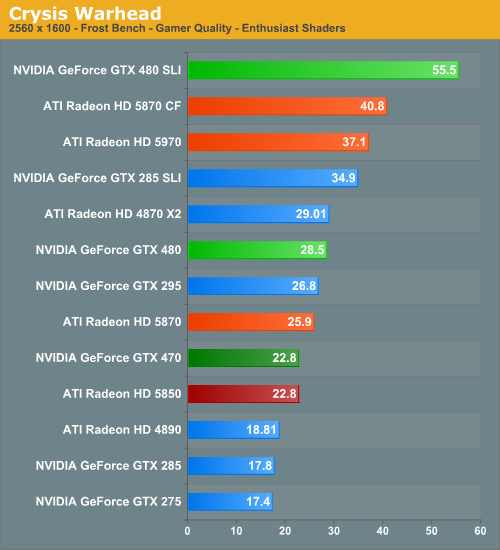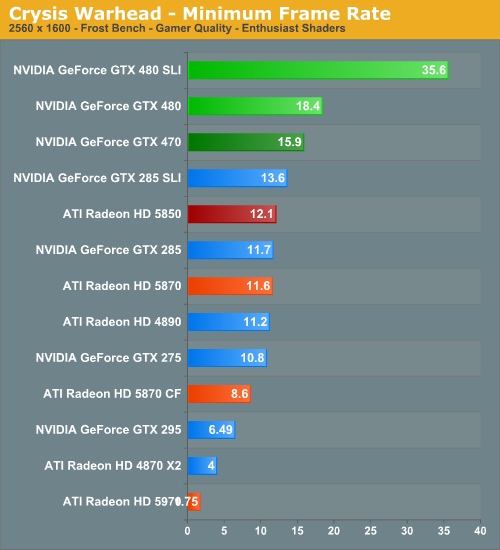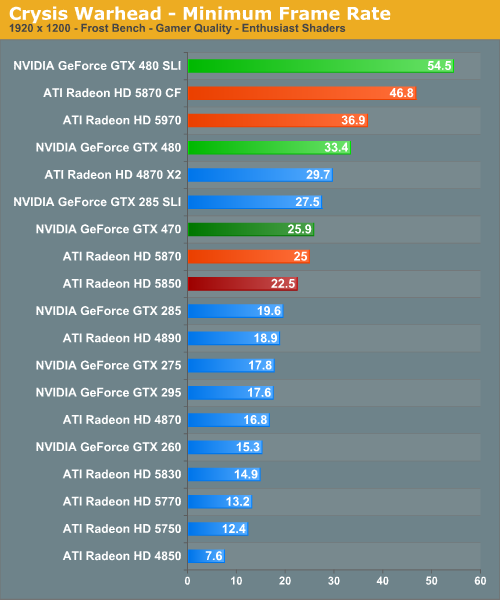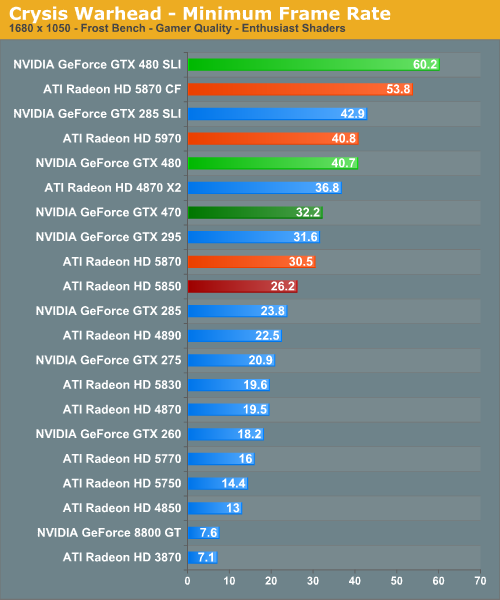NVIDIA’s GeForce GTX 480 and GTX 470: 6 Months Late, Was It Worth the Wait?
by Ryan Smith on March 26, 2010 7:00 PM EST- Posted in
- GPUs
Crysis: Warhead
It’s been over 2 years since the release of the original Crysis, and “but can it run Crysis?” is still a common question even today. With a mix of dense foliage, long draw distances, and high quality textures, Crysis is still a game that can bring any machine to its knees, and is our first choice for testing any video card.



As far as this first game is concerned, things are looking so-so for NVIDIA. For the GTX 480, it’s in a solid 10-12% lead over the 5870, and unsurprisingly losing to the 5970. For the GTX 470 things are less rosy; it basically is breaking even with the 5850. Furthermore there’s an interesting pattern in our averages: the gap between the GTX 400 series and the Radeon 5000 series shrinks with resolution. Keep an eye on this, it’s going to be a repeating pattern.



We’ve also gone ahead and recorded the minimum framerates for Crysis, as in our testing we’ve found the minimums to be very reliable. And in doing so, we have some data even more interesting than the averages. The GTX 400 series completely tramples the 5000 series when it comes to minimum framerates, far more than we would have expected. At 2560 Crysis is approaching a video RAM limitation in our 1GB and under cards, which gives the GTX 480 cards a clear lead at those resolutions. But even at lower resolutions where we’re not video RAM limited, the GTX 480 still enjoys a 33% lead in the minimum framerate, and the GTX 470 is well ahead of the 5850 and even slightly ahead of the 5870.
For whatever reason AMD can’t seem to keep up with NVIDIA when it comes to the minimum framerate, even at lower resolutions. Certainly it’s obvious when the 1GB cards are video RAM limited at 2560, but if we didn’t have this data we would have never guessed the minimum framerates were this different at lower resolutions.
Finally we have a quick look at SLI/CF performance. CF seems to exacerbate the video RAM limitations of the 5000 series, resulting in the GTX 480SLI coming in even farther ahead of the 5870CF. Even at lower resolutions SLI seems to be scaling better than CF.










196 Comments
View All Comments
deputc26 - Friday, March 26, 2010 - link
"GTX 480 only has 11% more memory bandwidth than the GTX 285, and the 15% less than the GTX 285."and holy server lag batman.
529th - Friday, March 26, 2010 - link
Thanks for the review :)ghost2code - Saturday, March 27, 2010 - link
I'm really impressed by this article author made a great job;) But about Fermi It's seem to be really good product for scientific matters but for gamers I'm not so sure about that. The price tag, power consumption, noise! this all is to much for only 10-15% of power more than above the cheaper and much more reasonable in all this things Radeon. I guess Fermi need some final touch from Nvidia and for now it's not a final , well tested product. Temp around 100 it's not good for PCB, GPU and all electronic and I don't believe it want metter for time-life and stability of the card. I'm glad the Farmi finally came but I'm dissapointed at least for now.LuxZg - Saturday, March 27, 2010 - link
I just don't know why GTX480 is compared to HD5870, and same for GTX470 vs HD5850.. GTX470 is right in the middle between two single-GPU Radeons, and just the same can be said for GTX480 sitting right in between HD5970 & HD5870.Prices of this cards as presented by nVidia/ATI:
HD5970 - 599$
GTX480 - 499$
HD5870 - 399$
GTX470 - 349$
HD5850 - 299$
I know GTX480 is single GPU, so by this logic you'll compare it to HD5870. But GTX480 is top of the line nVidia graphics card, and HD5970 is top of the line ATI card. Besides, ATI's strategy for last 3 product cycles is producing small(er) chips and go multi-GPU, while nVidia wants to go single-monolitic-GPU way.. So following this logic, indeed GTX480 should be compared to HD5970 rather than HD5870.
Anyway, conclusion of this article is all fine, telling both strengths and the weaknesses of solutions from both camps, but I believe readers weren't told straightforward enough that these cards don't cost the same... And HD5970 was left out of the most of the comparisions (textual ones).
If I personaly look at these cards, they are all worth their money. nVidia cards are probably more future-proof with their commitment to future tech (tessellation, GPGPU) but AMD cards are better for older and current (and close future) titles. And they are less hot, and less noisy, which most gamers do pay a lot of attention to. Not to say - this is first review of new card in which no one mentioned GPU overclocking. I'm guessing that 90+C temperatures won't allow much better clocks in the near future ;)
Wwhat - Sunday, March 28, 2010 - link
In regards to the temperature and noise: there's always watercooling to go to, I mean if you have so much money to throw at the latest card you might as well thrown in some watercooling too.It's too pricey for me though, I guess I'll wait for the 40nm process to be tweaked, spending so much money on a gfx card is silly if you know a while later something new will come around that's way better, and it's just not worth committing so much money to it in my view.
It's a good card though (when watercooled), nice stuff in it and faster on all fronts, but it also seems an early sample of new roads nvidia went into and I expect they will have much improved stuff later on (if still in business)
LuxZg - Tuesday, March 30, 2010 - link
Like I've said before - if you want FASTEST (and that's usually what you want if you have money to throw away), you'll be buying HD5970. Or you'll be buying HD5970+water cooling as well..ViRGE - Saturday, March 27, 2010 - link
I'm not sure where you're getting that the HD5970 is a $600 card. In the US at least, that's a $700 card (or more) everywhere.wicko - Sunday, March 28, 2010 - link
Honestly I don't even know if it should be mentioned at all even if it is 600, because there is almost no stock anywhere.LuxZg - Tuesday, March 30, 2010 - link
Oh, don't make me laugh, please! :D In that case this review shouldn't be up at all, or it should be called "PREview".. or have you actually seen any stock of GTX470/480 arround?LuxZg - Sunday, March 28, 2010 - link
It's AMD's & nVidia's recommended prices, and you can see them all in Anandtech's own articles:http://www.anandtech.com/video/showdoc.aspx?i=3783">http://www.anandtech.com/video/showdoc.aspx?i=3783 (nvidia prices)
http://www.anandtech.com/video/showdoc.aspx?i=3746">http://www.anandtech.com/video/showdoc.aspx?i=3746 (ATI single-gpu cards)
http://www.anandtech.com/video/showdoc.aspx?i=3679">http://www.anandtech.com/video/showdoc.aspx?i=3679 (ATI single/dual GPU cards)
It is not my fault that your US shops bumped up the price in the complete absence of competition in the high end market. But US is not only market in the world either.
You want to compare with real world prices? Here, prices from Croatia, Europe..
HD5970 - 4290kn = 591€ (recommended is 599$, which is usually 599€ in EU)
GTX480 - not listed, recommended is 499$/€
HD5870 - 2530kn = 348€ (recommended is 399$/399€ in EU)
GTX470 - not listed, recommended is 349$/€
HD5850 - 1867kn = 257€ (recommended is 299$/299€ in EU)
So let's say that European prices for GTX will be a bit lower than recommended ones, GTX480 would still be ~120-130€ pricier than HD5870, and HD5970 would be same ~120-130€ more expensive than GTX480.
As for the lower priced nVidia card, it's again firmly in the middle between HD5850 & HD5870.
Point is that there's no clear price comparision at the moment, and article's conclusion should be clear on that.
Person that wants the FASTEST CARD will stretch for another 100$/€ to buy HD5970. Especially since this means lower noise, lower consumption, and lower heat. This all combined means you can save a few $/€ on PSU, case, cooling, and earplugs, throwing HD5970 in the arm reach of the GTX480 (price-wise) while allowing for better speeds.
As for GTX470, again, lower consumption/heat/noise with ATI cards which means less expenses for PSU/cooling, and saving money on electrical bills. For me, well worth the 50€/$ difference in price, in fact, I'd rather spend 50$/€ more to buy HD5870 which is faster, less noisy, doesn't require me to buy new PSU (I own HD4890, which was overclocked for a while, so HD5870 would work fine just as well), and will save me 50W per hour of any game I play.. which will all make it CHEAPER than GTX470 in the long run.
So let's talk again - why isn't conclusion made a bit more straightforward for end users, and why is HD5890 completely gone from the conclusion??